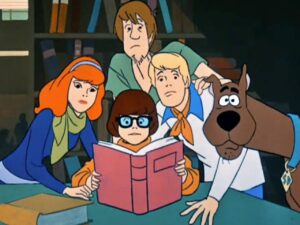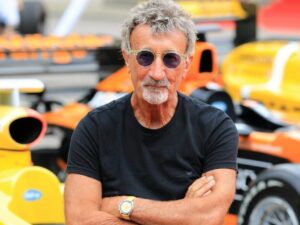The Wachowski Bros. brought us The Matrix, a film that redefined action sequences and challenged audiences to wrap their minds around a nightmarish vision of the future, now. The sci-fi actioner was revolutionary and set in motion a multi-million dollar franchise and a trilogy with diminishing returns.
It’s been 13 years since The Matrix and they still haven’t managed to better it. The Wachowskis have racked up film credits for The Matrix Reloaded, The Matrix Revolutions, Speed Racer, V for Vendetta and have even renamed themselves The Wachowski Starship, after Larry Wachowski became Lana Wachowski.
It’s been something of a rebirth for the sibling film-makers, who have now teamed up with Run Lola Run director, Tom Tykwer, to create a larger-than-life sci-fi odyssey. Cloud Atlas, an award-winning novel by David Mitchell was their inspiration – spawned after Natalie Portman reportedly gave Lana Wachowski a copy of the sci-fi epic on the set of V for Vendetta. Lana become obsessed with the book and the idea mutated into a near-impossible adaptation.
This ambitious film production is one of the biggest independent films ever made with an estimated $102 million budget, clocking in as Germany’s biggest blockbuster. Cloud Atlas, gives all three directors equal credit, despite shooting separate chapters with two parallel film units and their own crews. Cloud Atlas intertwines 6 stories across the ages into one epic, slowly unraveling a deep-seated interconnectedness as each story unburdens itself.
“We’ve got your number… Sonmi 451.”
The Pacific Journal of Adam Ewing(Wachowskis), an 1849 diary of an ocean voyage across the Pacific, is reminiscent of films like Amistad, Amazing Grace and Moby Dick, delving into a story of a sick man (Sturgess), a doctor (Hanks) and a slave (Gyasi) aboard a ship.
Letters from Zedelghem (Tykwer), turns letters from a composer (Whishaw) to his friend into a romantic drama with an inversion of the central relationship between an apprentice and a master in Gods and Monsters, as a young man forges his own path under the thumb of a renowned composer.
Half Lives: The First Luisa Rey Mystery (Tykwer), plays like a corporate espionage thriller in the vein of Erin Brockovich and Shaft as Luisa Rey (Berry) investigates a big business energy conspiracy in the ’70s.
The Ghastly Ordeal of Timothy Cavendish (Tykwer), delivers a healthy dose of small town British style comedy and levity to the film as a farce about a publisher (Broadbent) in a nursing home draws on elements from One Flew Over the Cuckoo’s Nest.
An Orison of Sonmi-451 (Wachowskis), embarks on a full-blown sci-fi thriller in the style of Blade Runner and The Fifth Element as Somni 451 (Bae), a rebellious clone in futuristic Korea, is forced to come to terms with her existence.
Sloosha’s Crossin’ an’ Ev’rythin’ After (Wachowskis), has shades of Escape from Absolom and The Fifth Element, in the tale of a tribesman (Hanks) grappling with his conscience in the wake of a murder in post-apocalyptic Hawaii.

“It is not the pen that bends, it is only yourself.”
The interconnectedness is sustained by a recurring cast, comprised of Tom Hanks, Halle Berry, Jim Broadbent, Hugo Weaving, Hugh Grant, Jim Sturgess, Doona Bae, Ben Whishaw, Keith David, James D’Arcy, Xun Zhou, David Gyasi and Susan Sarandon, who each play several characters of varying significance. A first-rate ensemble on any day, these actors combine their talents in a string of “supporting” roles to essentially deliver a love story for humanity.
Tom Hanks is the pick of the actors. He is the film’s Oscar hopeful – consistently good, iconic and most convincing as a full range of characters that all add up to what you’d call the lead genetic strain. Jim Broadbent adds heaps of experience to the cast and repeatedly functions as the film’s sense of humour. Hugo Weaving is a force to be reckoned with as the devil personified in his many incarnations. Halle Berry does justice to her main roles, while Hugh Grant is both the easiest and most difficult talent to recognise.
Jim Sturgess conveys grace under fire as both Adam Ewing and Hae-Joo Chang, with a strong supporting performance from Doona Bae as Sonmi 351. Ben Whishaw generates quiet resilience in his main role as Robert Fleischer, James D’Arcy epitomizes vulnerability, while Keith David, Susan Sarandon, Xun Zhou and David Gyasi round-off an excellent cast with key performances and steadfast reliability.

“Idle hands? Welcome to my playground.”
In much the same way as the novel, Cloud Atlas is so broad it encompasses almost every film genre. At times, the film’s editing makes it feel like you are trying to watch six movies simultaneously, channel-flipping between Amazing Grace, Blade Runner, Escape from Absolom, Highlander, One Flew Over the Cuckoo’s Nest and The Fifth Element. The range of genres, periods and characters is enough to make your head spin and for the first 90 minutes it’s anyone’s guess as to what is happening.
How do you throw a blanket over six completely different films? The secret to the continuity is mostly thanks to the smart editing and undulating soundtrack, which uses graphic and sound matches to dexterously slide from one scene to the next without derailing the viewer. This, coupled with the stream of familiar faces, mis-en-scene and distinct locations, provides us with a filing system to lock sequences into place. Cloud Atlas requires your full concentration and while at times lofty and pretentious even, manages to hold our attention.
The stream of consciousness brought forth by a flurry of beautiful visuals and locations is made all the more enjoyable by transporting us back-and-forth in time, much like Highlander. In this case, the directors have the remote control of mortality and are delivering a transcendent message about the nature of humanity through several stories, with different skins, that share the same subtext. Cloud Atlas dabbles with reincarnation, an aspect that has been emphasised in the film, and parallels scenarios, in which the characters are forced to break free from their shackles: societal, physical and mental.

“I’m going to help you rediscover your manhood.”
If you drop the names, Cloud Atlas is very ‘unHollywood’. The odyssey has stronger parallels with Hayao Miyazaki’s animated films, which transcend on an emotional and spiritual level. It’s as if the Wachowskis and Tom Tykwer are trying to unite the characters under one banner by reducing (or elevating) them to a space where each soul shares the past, present and future. This cloaks Cloud Atlas with a sense of ambiguous spirituality, which like Groundhog Day, could be reinterpreted to align itself with several ideologies and world religions.
Cloud Atlas may be epic, but it’s the sort of film that will polarise audiences. In much the same way as The Tree of Life, this film is a pioneer, which is why it will be labeled as ambitious until others attempt something similar. At almost three hours, you would expect a lull, but Cloud Atlas is filmed like a collation of highlights… delivering short sharp bursts of quality entertainment from each world.
Cloud Atlas is sprawling to the point that you actually need time for the experience to settle in your mind. Just like Inception and The Matrix, it’s the sort of film that actually needs to be seen twice. The first viewing is like a snapshot. Your eyes let in enough information to leave an impression, which requires some unpacking and thought before you actually engage with Cloud Atlas a second time in the dark room. The second viewing experience gives you a box for the puzzle, and having the full picture allows you to catch up with the emotional undercurrent.

“I want to know what love is, m’lady…”
The film has been criticised for being pretentious, but it’s an adaptation and the script has been written to accommodate the tone and register of David Mitchell’s novel with a view to making the film accessible to everyone. The prosthetics and make up department have outdone themselves and it’s a game within itself to recognize recurring actors, who are all displayed in their big and small parts in the credits. However, the treatment of the Asian male characters is distracting to offensive and makes them look more Vulcan than Asian.
Tom Tykwer, Andy and Lana Wachowski have composed a beautifully haunting epic, which will linger with you for days after your initial exposure. Cloud Atlas is characterised by mesmerising visuals, vivid entertainment, a beautiful score, slick editing, solid performances, a thought-provoking script and an interconnected story upon stories. With enough content to power several films, this mind-blowing epic leaves you bewildered and wanting more… making it a must-see, twice.
The bottom line: Captivating
 Now Showing
Now Showing
Book Tickets at Ster-Kinekor
Book Tickets at Nu Metro
Catch more movie reviews at SPL!NG






